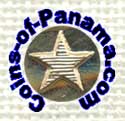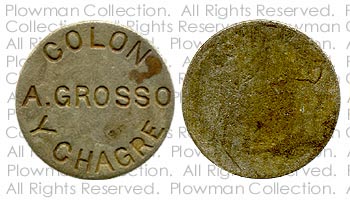|
Obverse Design
|
The legend "COLON" curves along the top.
The legend "Y CHAGRE" curves along the bottom.
Across the middle is the legend "A. GROSSO".
All these legends use incuse lettering.
The token has a smooth edge without a rim.
|
|
Reverse Design
|
The reverse side of this token is blank. It has a smooth edge without a rim.
|
|
Metal
|
White metal, perhaps silver.
|
Size and Shape
|
Round, 20 mm in diameter.
|
|
Dates Issued
|
Probably sometime between 1851 and 1853.
|
|
Issurer
|
A. Grosso.
|
|
Mintage
|
Unknown.
|
|
Rarity
|
Very Rare.
|
Manufacturer
|
Unknown.
|
Source
|
Henkle's Colon #3, Mizrachi's F-8,
Rulau's Col 39, Plumer page #1.
|
|
Varieties
|
None known.
|
|
Function
|
Merchant token.
|
|
Population Count
|
Known specimens are as follows:
- King Specimen.
- Plowman Specimen, pictured above. Private sale, September 2002.
Jerald Peterson, who made the metal detector find, reported finding about three
of these tokens over time.
|
|
Notes
|
Chagre was a fishing village at the mouth of the Chagre (present day Chagres) River.
It experienced a brief boom from about 1850 to 1852 when it functioned as the
Atlantic terminus of the trans-Istmus route during the California gold rush.
The boom ended when the
Panama Railroad was long enough to be useful, and the railroad town of Colon
(founded in 1850) became the new Atlantic terminus. This token appears to have
been issued during the transition period when both towns were important enough
to be mentioned on the token. The example above was a metal detector find at the
mouth of the Chagres River, and was found near United States half-dimes from the
1840's.
|



